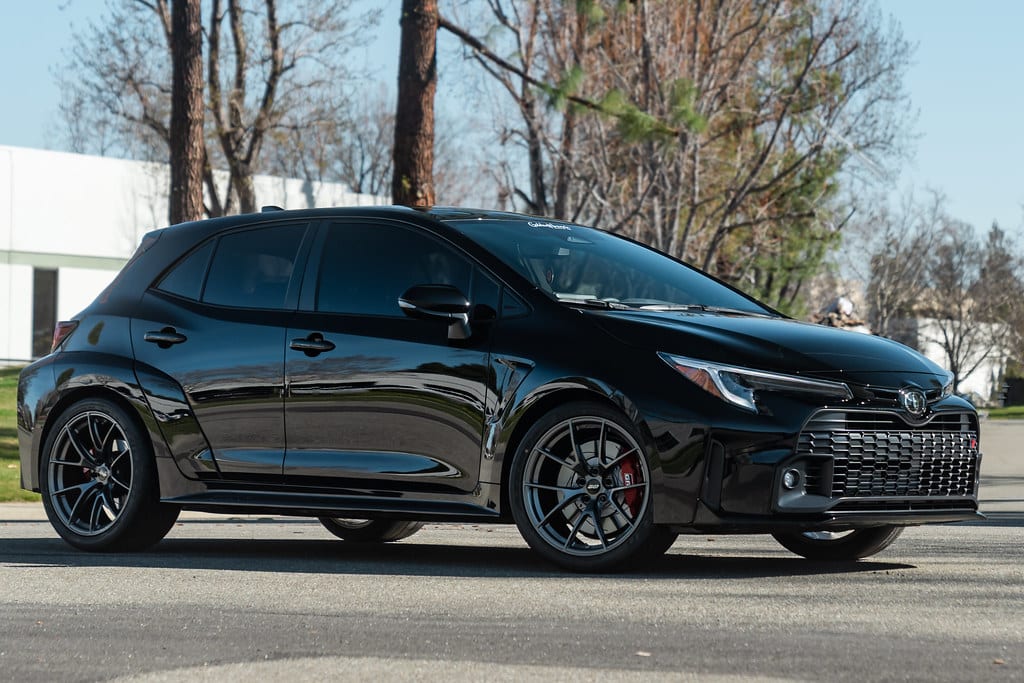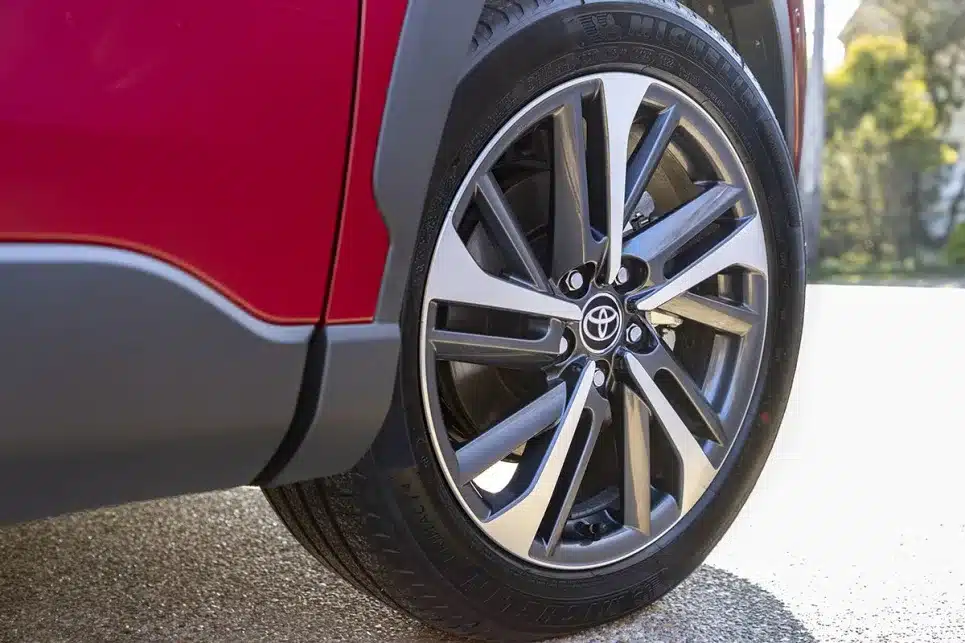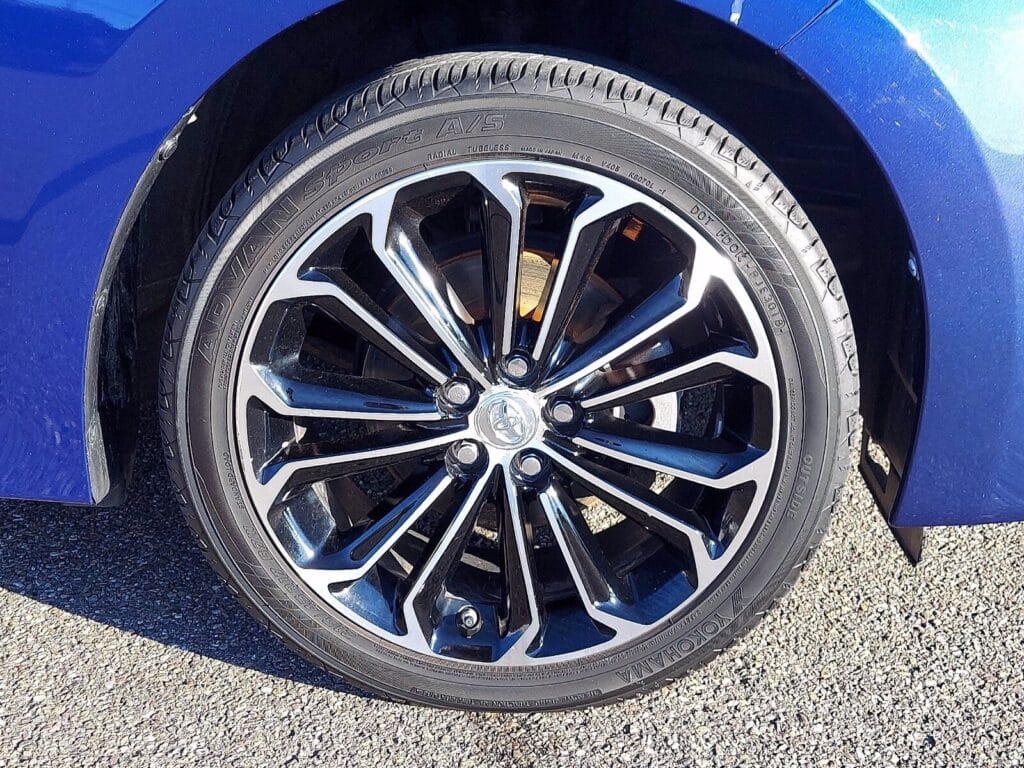Are you Confused about your Toyota Corolla’s wheel sizes?
You’re not alone.
Many owners want to know how wheel sizes have changed and what that means for their cars.
In this guide, you’ll learn how Toyota Corolla wheel sizes have grown and changed since the car’s early days.
You’ll learn–
- Your ride comfort
- How your car handles the road
- The overall look of your vehicle
As a Toyota owner, I’ve spent years tracking these changes.
I’ll share examples from different Corolla models and help you understand what works best for your specific year and driving needs.
By the end of this article, you’ll know exactly which wheel sizes fit your Corolla and how different options might affect your driving experience.
Let’s start with the basics and build from there.
Early Generations: Smaller Wheels for Simplicity

When the first Corolla hit the streets in 1966, Toyota kept things basic.
The car came with 12-inch wheels—about the size of a large dinner plate.
Why so small?
Let me break it down for you:
- Small wheels cost less to make
- They worked well with the light cars of that time
- Tires were cheaper to replace
- These wheels made the car easy to handle
Between 1966 and 1980, most Corollas had either 12—or 13-inch wheels.
Toyota focused on making cars people could afford and maintain easily, and the small wheels helped keep the price low.
Here’s something interesting: those tiny wheels actually helped save gas.
The smaller and lighter the wheel, the less work your engine had to do to move it.
You might find these early wheel sizes funny compared to today’s cars, but they made perfect sense at the time.
Toyota aimed to build reliable cars that wouldn’t break the bank.
Modernizing the Corolla: Bigger Wheels for Performance

The 1990s brought big changes to the Corolla.
Toyota started offering 14-inch wheels on most models, and some even had 15-inch wheels as an option.
This wasn’t just about looks—it also improved car driving.
What changed in the 90s?
- Steel wheels became less common
- Light alloy wheels became the new standard
- Wheel width increased for better grip
- Tire walls got shorter for sharper turns
Let me tell you about some specific models.
The 1993 Corolla came with 14-inch wheels standard.
By 1998, you could get 15-inch wheels on some models.
When the 2001 model emerged, 16-inch wheels were available on higher-end versions.
Why did these changes matter?
Bigger wheels helped your Corolla:
- Stay steadier on highways
- Turn corners with more control
- Stop more quickly
- Feel more stable in bad weather
I’ve noticed that many Corolla owners from this era say their cars felt more solid than older models.
The bigger wheels played a big part in this, giving the car a wider stance and better balance.
Some sports models even offered special wheel packages.
The XRS trim, for example, came with unique alloy wheels that set it apart from regular models.
Recent Trends: Sleek and Stylish Designs
Let’s look at what’s changed since 2010.
The base Corolla now comes standard with 16-inch wheels.
But what’s really interesting is that many buyers choose the optional 17- and 18-inch wheels.
Why are bigger wheels so popular now?
- They fill out the wheel wells better
- The car sits lower and looks more sporty
- Wider tires grip the road better
- Modern designs catch the eye
I’ve noticed that hybrid Corollas use special wheels.
These wheels have flat faces and small gaps between spokes, which helps the car slip through the air more easily and saves fuel.
What’s different about today’s wheel options?
- Two-tone color choices
- Machine-finished faces
- Black-painted accents
- Special hybrid designs
You’ll see most newer Corollas with these wheel sizes:
- L and LE: 16-inch steel or alloy
- SE and XSE: 17-inch alloy
- Sport models: 18-inch alloy
The latest models show how far we’ve come from those tiny 12-inch wheels.
Today’s Corolla offers many choices to match your style and driving needs.
But remember – bigger isn’t always better.
While large wheels look great, they can make the ride firmer and cost more to replace.
Customization and Aftermarket Trends
Many Corolla owners want to customize their cars.
Aftermarket wheels allow them to do just that.
Based on my experience, most people choose wheels between 17 and 19 inches.
Popular aftermarket choices:
- Light alloy wheels for better speed
- Split-spoke designs for a clean look
- Bronze and black finishes for style
- Wider wheels for more road grip
But before you swap your factory wheels, let’s look at the good and not-so-good points.
Benefits of aftermarket wheels:
- More style options
- Better brake cooling
- Lighter weight possible
- Wider tire choices
Things to watch out for:
- It might affect your warranty
- Can change how your car rides
- Often cost more than factory wheels
- May need different tire sizes
I’ve noticed that most Corolla owners use 17-inch wheels for daily driving.
This size gives the car a good look without making the ride too harsh.
Here’s a tip: Talk to other Corolla owners first if you plan to change your wheels.
They can tell you what works well in real life.
Also, check your owner’s manual for size limits—going too big can damage your car’s systems.
Remember: the best wheel choice should match how you use your car.
A show car needs wheels that are different from the ones you drive every day in all weather.
Factors Influencing Wheel Size Changes Over the Years
1. Better Materials and Technology
I’ve watched wheel making change a lot. In the past, we only had steel wheels.
Now, we can mix metals to make wheels both light and strong.
New machines let makers try different shapes while keeping wheels safe.
2. What Buyers Want
You might notice how car buyers’ wishes changed over time. Today’s drivers ask for:
- Wheels that look good
- Better handling on turns
- Quiet, smooth rides
- Options to make their car unique
3. Safety Rules Matter
New safety rules changed how we make wheels. They must:
- Handle higher speeds safely
- Work well with modern brakes
- Pass tough crash tests
- Last longer on the road
4. Keeping Up with Others
When other car makers started using bigger wheels, Toyota had to follow.
But they did it smartly.
Each change had to make sense for the Corolla’s price and what buyers wanted.
5. Saving Gas, Helping Earth
Green thinking changed wheels, too. New designs help:
- Cut downwind drag
- Lower car weight
- Save fuel
- Reduce tire noise
6. Looking Good Matters More
The style became more important. People now want:
- Shiny finishes
- Special colors
- Unique patterns
- Custom looks
7. Special Needs for New Cars
Hybrid and electric Corollas need different wheels. They’re made to:
- Cut through the air better
- Make less noise
- Help save battery power
- Keep the car stable
Tips for Selecting the Best Wheels for Your Corolla
1. Match Your Model and Year
Check your owner’s manual first.
Each Corolla year has its perfect fit. Going too big or too small can cause problems.
I always tell people to stick to what Toyota suggests when in doubt.
2. Get the Right Offset and Width
Think of offset as how your wheel sits in the wheel well.
The wrong offset makes your wheels stick out or sit too far in.
Width affects how your tires fit. Both need to be just right for safe driving.
3. Alloy vs. Steel: Make Your Pick
- Steel wheels: tough and cheap to fix
- Alloy wheels: light and good-looking
- Your choice depends on your roads and budget
4. Watch Your Gas Money
Bigger, heavier wheels use more gas. Lighter wheels help save fuel.
Think about what matters more to you – looks or fuel costs.
5. Think About Your Roads
Where do you drive most?
Rough roads need tough wheels. Smooth highways let you use fancier options.
Match your wheels to your daily drive.
6. Follow Size Limits
Toyota tests its size recommendations carefully. Going outside these limits can:
- Mess up your speedometer
- Strain your brakes
- Make your car handle poorly
7. Don’t Buy Cheap
Good wheels cost more for a reason.
They’re safer and last longer. Saving money now might cost you more later.
8. Pick Known Brands
I’ve seen too many problems with off-brand wheels.
Stick to brands other Corolla owners trust. Ask around in owner groups for suggestions.
9. Get Expert Help
Let pros handle the installation. They’ll make sure your:
- Wheels are balanced right
- Car stays aligned
- Tires wear evenly
Common Mistakes When Choosing Corolla Wheel Size
1. Not Thinking About Gas Money
Bigger wheels can hit your wallet at the pump.
Many people are surprised when their gas costs go up after wheel upgrades.
Each extra inch of wheel size adds weight, and weight uses more fuel.
2. Wrong Widths and Offsets
This is a big one. Getting these numbers wrong can cause:
- Wheels that rub against your car
- Odd tire wear
- Poor handling
- Stress on your wheel bearings
3. Tire Problems
Your wheels and tires must work as a team. I often see folks pick wheels without checking:
- If tires come in that size
- How much good tires will cost
- Whether the tires fit their driving needs
- If the tires work in their local weather
4. Buying Cheap Brands
I get it – saving money feels good. But cheap wheels can:
- Break more easily
- Bend out of shape
- Rust quickly
- Cause safety issues
5. Choosing Looks Over Safety
Sure, those huge, shiny wheels look cool. But ask yourself:
- Will they handle it well?
- Can they take a pothole hit?
- Do they work with your car’s systems?
- Will they keep you safe in bad weather?
Essential Facts About Toyota Corolla Wheel Sizes
1. Know Your Model’s Needs
Each Corolla model year has its wheel size specs.
A 2015 Corolla’s perfect fit isn’t the same as a 2022’s.
I’ve learned that this matters more than most people think.
2. Bigger Isn’t Always Better
While large wheels might look nice, they can make your ride bumpier.
Think about it: fewer tires mean less cushion between you and the road.
You’ll feel every bump and crack more clearly.
3. Hybrid Models Are Special
Toyota gives hybrid Corollas special wheels that cut through the air better.
These wheels:
- Have fewer gaps between spokes
- Sport flatter faces
- Help save more fuel
- Keep wind noise down
4. Watch Your Warranty
Putting on aftermarket wheels?
Check your paperwork first.
Some changes might cancel parts of your warranty. I always tell folks to read the fine print.
5. Steel vs. Alloy Facts
Steel wheels
- Cost less
- Take hard hits better
- Weigh more
- Look plain
Alloy wheels
- Look better
- Weigh less
- Cost more
- Need more care
6. Low-Profile Tire Truth
Thin tires look sporty but need more attention.
You’ll likely:
- Replace them more often
- Pay more for each tire
- Need to watch for road damage
- Feel more road bumps
7. Braking Changes
Wheel size affects how your car stops.
Larger wheels can help your brakes work better by:
- Cooling the brakes faster
- Giving more grip
- Adding stability
- Improving brake feel
Remember: what works for show cars might not work for daily drives.
Pick what fits your real needs.
Top Wheel Brands for Toyota Corolla Owners

Let me share the most trusted wheel brands I’ve seen work well with Corollas.
Each has its strengths, and I’ve ranked them based on owner feedback and quality.
1. Enkei
- Known for light but strong wheels
- Good price for what you get
- Lots of sizes for Corollas
- Popular with daily drivers
2. BBS
- Top-quality materials
- Hand-finished details
- Costs more than others
- Loved by car show fans
3. OZ Racing
- Made in Italy
- Strong racing background
- Good for sport driving
- Lots of style choices
4. Konig
- Fits most budgets
- Good middle-ground option
- Many style choices
- Easy to find and buy
5. American Racing
- Built tough
- Simple, clean looks
- Good for rough roads
- Fair prices
6. Motegi Racing
- Modern styles
- Good for younger owners
- Won’t break the bank
- Easy to maintain
7. Toyota OEM Wheels
- Perfect fit guaranteed
- Keep your warranty safe
- It is the same as factory quality
- Best for resale value
Remember: buying from these trusted brands costs more upfront but saves money over time.
They last longer and cause fewer problems.
Conclusion
We’ve seen how Corolla wheels evolved from simple 12-inch steel rims to today’s wide range of options.
What started as basic transport has become a blend of style and function.
Your perfect wheel choice depends on what matters most to you:
- How you use your car each day
- The roads you drive on
- How much you want to spend
Before you make any changes to your Corolla’s wheels, talk to a trusted mechanic or wheel expert.
They can help you pick options for your specific model and needs.
Want to learn more?
Join Corolla owner groups online.
Other owners’ real-world experiences can help you make smart choices for your car.
Frequently Asked Questions
Do Larger Wheels Affect Fuel Economy?
Yes, larger wheels often reduce fuel economy due to their increased weight and rolling resistance.
When upgrading, it’s important to consider this trade-off.
Are Alloy Wheels Better Than Steel Wheels for the Corolla?
Alloy wheels are lighter and more stylish, improving handling and aesthetics.
Steel wheels are durable and cost-effective, ideal for budget-conscious or winter driving needs.
What Are Low-Profile Tires, and Should I Use Them?
Low-profile tires have shorter sidewalls, offering a sporty look and better handling.
However, they reduce ride comfort and may wear out faster.


